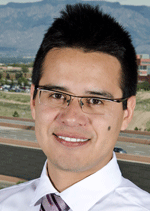Recent News
Ferenchak named chair of Transportation Research Board Pedestrian Committee
October 31, 2025
Ferenchak named APBP 2025 Research Professional of the Year
October 1, 2025
UNM professor to speak at TEDxABQ event
September 24, 2025
NSF funds research to investigate whether treated wastewater can help mitigate water scarcity in arid regions without compromising river ecosystem health
September 2, 2025
News Archives
Dr. Gonzalez-Pinzon Successfully Led Two NSF Proposals, Totaling Close to $1.4 Million Dollars, Awarded by Two Different NSF Programs
August 10, 2017
 In the first project funded by the NSF Hydrologic Sciences program, Dr. Gonzalez-Pinzon is the lead PI in a team of researchers from the University of New Mexico, University of Colorado (Dr. Michael Gooseff), Colorado School of Mines (Dr. Kamini Singha) and Colorado State University (Dr. Timothy Covino). This team is working on the project “Collaborative Research: How do interactions of transport and stoichiometry maximize stream nutrient retention?”. The team will conduct studies over the next three years in three contrasting Critical Zone Observatory (CZO) sites: 1) Boulder Creek, a rocky mountain setting in Colorado; 2) Catalina-Jemez, a low nutrient setting in New Mexico; and 3) an agricultural landscape in Iowa. They will deploy and use a suite of field and modeling methods to test their hypotheses on how the supply and demand of carbon, oxygen and nutrients vary in multiple stream compartments and contribute to control nutrient retention and export in streams. The project will engage multiple graduate students with an emphasis on diversity. The team will also organize a workshop to promote and stimulate interaction and exchange of ideas and knowledge among the principal players in the stream restoration field, particularly young scientists and practitioners, stream restoration companies and local environmental agencies.
In the first project funded by the NSF Hydrologic Sciences program, Dr. Gonzalez-Pinzon is the lead PI in a team of researchers from the University of New Mexico, University of Colorado (Dr. Michael Gooseff), Colorado School of Mines (Dr. Kamini Singha) and Colorado State University (Dr. Timothy Covino). This team is working on the project “Collaborative Research: How do interactions of transport and stoichiometry maximize stream nutrient retention?”. The team will conduct studies over the next three years in three contrasting Critical Zone Observatory (CZO) sites: 1) Boulder Creek, a rocky mountain setting in Colorado; 2) Catalina-Jemez, a low nutrient setting in New Mexico; and 3) an agricultural landscape in Iowa. They will deploy and use a suite of field and modeling methods to test their hypotheses on how the supply and demand of carbon, oxygen and nutrients vary in multiple stream compartments and contribute to control nutrient retention and export in streams. The project will engage multiple graduate students with an emphasis on diversity. The team will also organize a workshop to promote and stimulate interaction and exchange of ideas and knowledge among the principal players in the stream restoration field, particularly young scientists and practitioners, stream restoration companies and local environmental agencies.
In the second project funded by NSF Environmental Engineering, Dr. Gonzalez-Pinzon will work with Dr. Van Horn (UNM’s Department of Biology) to monitor water quality parameters and dissolved organic carbon along the Jemez River-Rio Grande continuum. The objective of this project is to develop a spatially and temporally holistic, watershed-level understanding of nutrient dynamics in an arid land river network. Arid lands cover approximately 40% of the Earth’s land surface, are inhabited by approximately 1/3 of the Earth’s human population, and contain ~1/2 of the world’s cultivated land. Excess nutrient loading is one of the most common and disruptive disturbances to river ecosystems, and the negative impacts extend to downstream lakes, aquifers and coastal waters that are highly susceptible to nutrient loading, with estimated associated damage costs in the US of ~100 billion dollars per-year. Results from this project will provide methods to assess the transport and fate of carbon and nutrients in river networks, promote a more complete understanding of the complex connections between water resources and nutrient cycles, and provide information about ways to reduce pollution and increase nutrient recycling.
